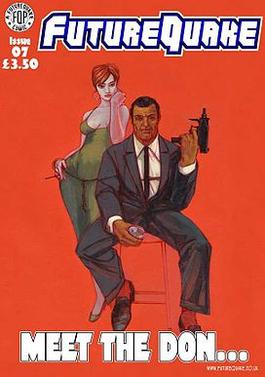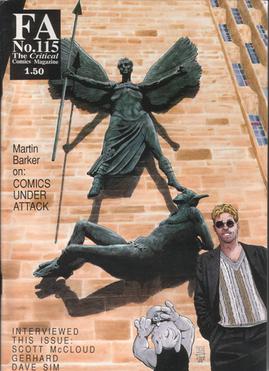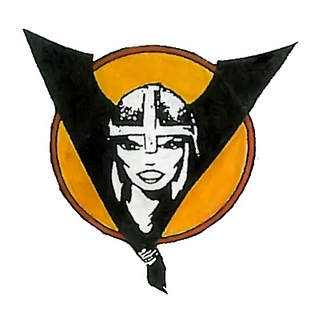Related Research Articles

2000 AD is a weekly British science fiction-oriented comic magazine. As a comics anthology it serialises stories in each issue and was first published by IPC Magazines in 1977, the first issue dated 26 February. Since 2000 it has been published by Rebellion Developments.
Tharg the Mighty or The Mighty One is the fictional editor of the British science fiction comic 2000 AD. The character was introduced on the cover of the first issue in 1977 and is one of only two characters to appear in almost every issue of the comic, the other being Judge Dredd. Tharg rarely appears in stories but strips involving him have been written by such notable writers as Alan Grant, Alan Moore and John Wagner, albeit usually credited to "TMO" – "The Mighty One".
BEM or Bem may refer to:
Phil Elliott is a British comic book creator who was published in Escape Magazine. He was part of the British small press comics scene in the 1980s.
The Eagle Awards were a series of British awards for comic book titles and creators. They were awarded by UK fans voting for work produced during the previous year. Named after the UK's seminal boys' comic Eagle, the awards were launched in 1977 for comics released in 1976.

FutureQuake was a British small press comic book founded by Arthur Wyatt, and later edited by Richmond Clements, David Evans and Owen Watts. Dedicated to showcasing work by new writers and artists, they published mostly self-contained comic stories, generally of 5 pages or less and usually of a sci-fi/fantasy/horror bent.

Fantasy Advertiser, later abbreviated to FA, was a British fanzine focused on comic books, founded in 1965 by Frank Dobson, the "Godfather of British Fandom." Starting out as an adzine focused on the sale of primarily second-hand comics, it eventually transitioned into a true comics fanzine. FA now operates as a comics webzine.
Zarjaz is a comics anthology fanzine for the long-running British science fiction comic 2000 AD.

Valkyrie Press was a British publisher of comics that operated from 1987 to 1989. It published Fox's Redfox, and Bryan Talbot's The Adventures of Luther Arkwright, both of which won Eagle Awards. Valkyrie Press was owned by Redfox co-writer Chris Bell and jointly operated by Bell and Redfox artist Fox.
Richard Burton is a British comic publisher and editor who had a lengthy career at IPC Magazines. While an assistant editor at 2000 AD, he became known to readers as Tharg the Mighty's bumbling assistant Burt, who appeared in a number of strips with him. Earlier in his career, Burton published the popular fanzine Comic Media News, and was a co-founder of the Eagle Awards.
New Media Distribution/Irjax Enterprises was a comic book distributor and publisher active from the mid-1970s to the mid-1980s. In 1978, the company's legal actions against the dominant distributor of the era, Sea Gate Distributors, widened the field for the direct market to expand. In 1982, when Irjax's distribution arm went out of business, its processing centers and warehouses formed the basis for Diamond Comics Distributors, the now-dominant comics distributor.

The Comic Reader (TCR) was a comics news-fanzine published from 1961 to 1984. Debuting in the pre-direct market era, TCR was the first regularly published comics industry news fanzine, and was able to secure many contacts from within the ranks of the larger publishers. As TCR increased in popularity and influence, it was able to attract professional artist to illustrate the covers. TCR also proved to be a launching pad for aspiring comic book creators, many of whom published work in the fanzine as amateurs. Contributors from the world of fandom included founding editor Jerry Bails, key editor Paul Levitz, Paul Kupperberg, Tony Isabella, Byron Preiss, Neal Pozner, Don Rosa, Carl Gafford, and Doug Hazlewood.

Harrier Comics was a British comic book publisher active in the mid-to-late 1980s. Harrier was notable for putting out black-and-white comics in a mold more similar to American comics than to typical British fare.

The British Comic Art Convention was an annual British comic book convention which was held between 1968 and 1981, usually in London. The earliest British fan convention devoted entirely to comics, it was also the birthplace of the Eagle Awards.

Speakeasy was a British magazine of news and criticism pertaining to comic books, comic strips and graphic novels. It published many interviews with both British and American comics creators.

BEM, originally known as Bemusing Magazine, was a British fanzine focused on comic books which was published from 1973 to 1982. The brainchild of Martin Lock and billed as "The Comics News Fanzine," BEM featured American and British comics industry news and gossip, interviews, comic reviews, essays, columns, and comic strips.

Comics Feature was an American magazine of news, criticism, and commentary pertaining to comic books, comic strips, and animation. Published by New Media Publishing, it produced 57 issues between 1980 and 1987.
Comic Mart is the catchall term for a series of British comic book trade fairs which were held in the United Kingdom from 1972 until the early 1990s. The Comic Mart was one of the earliest recurring public comic events in the UK, predated only by the British Comic Art Convention. Comic Mart began in London, eventually expanding to Birmingham, Manchester, and Liverpool, among other locations. The first few Comic Marts were organized and produced by Rob Barrow and Nick Landau; eventually they split up to produce competing versions of the event, and were joined by other regional organizers.
Trevor Goring is a British artist who has worked in the comic book industry and the film industry. His comics work includes 2000 AD, House of Hammer, and Death Race 2020. Since the mid-1990s Goring has mostly focused on being a storyboard artist, working on such films as Independence Day, The Cell, Gattaca, X2, Watchmen, and The Cabin in the Woods.
References
- 1 2 3 4 Willis, Russell. "AN INTERVIEW WITH MARTIN LOCK (PART THREE | THE HARRIER COMICS YEARS)," Under the Stairs (2013). Accessed Feb. 8, 2020.
- 1 2 3 Willis, Russell. "AN INTERVIEW WITH MARTIN LOCK (PART TWO | THE FANTASY ADVERTISER YEARS)," Under the Stairs (2013). Retrieved Feb. 8, 2020.
- ↑ BEM #15 (Sept. 1977).
- 1 2 3 4 5 Willis, Russell. "AN INTERVIEW WITH MARTIN LOCK (PART 1 | THE BEM YEARS)," Under the Stairs (2013). Retrieved Jan. 8, 2020.
- ↑ Lock. Martin. "News at BEM," BEM #15 (Sept. 1977), p. 2.
- ↑ Burton, Richard. "Meditorial," Comic Media News #31 (June/July 1977).
- 1 2 "Fan Press," The Comics Journal #50 (Oct. 1979), p. 19.
- 1 2 Previous Winners: 1977, at the official Eagle Awards website, archived at the Wayback Machine. (Retrieved 9 September 2018.)
- ↑ Previous Winners: 1978, at the official Eagle Awards website, archived at the Wayback Machine. (Retrieved 9 September 2018.)
- ↑ "The Eagle Awards 1979," BEM #31 (Dec. 1980), p. 32.
- ↑ "Marvel's X-Men Sweep British Eagle Awards," The Comics Journal #69 (Dec. 1981).
- ↑ "Newswatch: New Media Distribution out of Business," The Comics Journal #72 (May 1982), p. 16.
- ↑ Gavin Burrows, "Bookmark this, comic fans! The return of sweet 'FA'", Lucid Frenzy Junior, 8 November 2010
- ↑ Gavin Burrows, "Comics & My Life part 2" Archived 7 June 2011 at the Wayback Machine , Vicious #5, July 1996, hosted at BugPowder
- ↑ "Newswatch: Harrier News," The Comics Journal #97 (April 1985), p. 19.
- ↑ Martin Lock credits, Grand Comics Database. Retrieved Jan. 9, 2020.